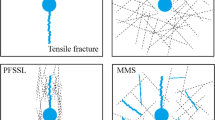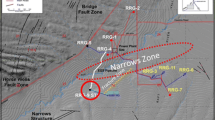Abstract
Is there any method to study the feasibility of water injection into naturally fractured geothermal reservoirs before implementing liquid injection? How can we identify the difference of water injectability between different reservoirs? Spontaneous water imbibition tests in rocks from The Geysers and in Berea sandstone have been designed to answer these questions. The maximum water saturation and the maximum imbibition rate by spontaneous water imbibition were used to evaluate the feasibility and the ability of water injection into geothermal reservoirs. Reservoirs with high imbibition rates and high maximum water saturation are good candidates for water injection. If there is no imbibition of water into the rocks at all, then the reservoir is not suitable for water injection. The relationships between imbibition rate and time for The Geysers rocks have been measured under countercurrent and cocurrent imbibition conditions, respectively. The measured maximum water saturation by the spontaneous water imbibition in The Geysers rock was about 87.9%, which was greater than that in Berea although the imbibition rate was lower. Experimental results and the continuing practice of water injection in the field showed that The Geysers geothermal reservoir may be appropriate for water injection.
Similar content being viewed by others
Abbreviations
- A :
-
cross-section area of the core
- A i :
-
area open to imbibition at the ith direction
- k :
-
rock permeability
- k w :
-
effective permeability of water phase at a water saturation of S wf
- L c :
-
characteristic length
- N wt :
-
volume of water imbibed into the core boundary
- P c :
-
capillary pressure at S wf
- q w :
-
water imbibition rate
- q wmax :
-
maximum water imbibition rate
- S wf :
-
water saturation behind the imbibition front
- S gr :
-
residual gas saturation in rocks
- S wi :
-
initial water saturation, in this study, it was equal to zero
- S wmax :
-
maximum water saturation
- t :
-
imbibition time
- t D :
-
dimensionless time
- V :
-
bulk volume of the matrix
- V p :
-
pore volume of the reservoir
- X Ai :
-
distance traveled by the imbibition front from the open surface to the no-flow
- σ :
-
interfacial tension between oil and water
- \({\phi}\) :
-
porosity
- θ :
-
contact angle
- λ :
-
constant giving the rate of convergence in Eq. 1
- μ m :
-
geometric mean of water and oil viscosities
- μ w :
-
viscosity of water
- η :
-
recovery in terms of recoverable resident fluid by spontaneous water imbibition
- η * :
-
gas recovery in terms of gas originally in place
References
Aronofsky J.S., Masse L., Natanson S.G. (1958) A model for the mechanism of oil recovery from the porous matrix due to water invasion in fractured reservoirs. Trans. AIME 213: 17–19
Behbahani H.S., Di Donato G., Blunt M.J. (2006) Simulation of counter-current imbibition in water-wet fractured reservoirs. J. Pet. Sci. Eng. 50(1): 21–39
Bourblaux, B.J., Kalaydjian, F.J.: Experimental study of cocurrent and countercurrent flows in natural porous media, SPERE, 361–368 (1990)
Goyal, K.P.: Injection experience in The Geysers, California—a summary, paper presented at the 1999 GRC annual meeting held in Reno, NV, October 17–20, GRC Trans. 23 (1999)
Handy L.L. (1960) Determination of effective capillary pressures for porous media from imbibition data. Trans. AIME 219: 75–80
Li, K., Firoozabadi, A.: Experimental study of wettability alteration to preferential gas-wetness in porous media and its effect, SPEREE, 139–149 (2000)
Li K., Horne R.N. (2001) Characterization of spontaneous water imbibition into gas-saturated rocks. SPEJ (December) 6(4): 375–384
Li K., Horne R.N. (2006) Fractal modeling of capillary pressure curves for The Geysers rocks. Geothermics 35: 198–207. doi:10.1016/j.geothermics.2006.2.001
Ma, S., Morrow, N.R., Zhang, X.: Generalized scaling of spontaneous imbibition data for strongly water-wet systems, paper 95-138, presented at the 6th Petroleum Conference of the South Saskatchewan Section, the Petroleum Society of CIM, held in Regina, Saskatchewan, Canada, October 16–18 (1995)
Schembre, J.M., Akin, S., Castanier, L.M., Kovscek, A.R.: Spontaneous water imbibition into diatomite, paper SPE 46211, presented at the 1998 Western Region Meeting, Bakersfield, California, May 10–13 (1998)
Schechter, D.S. Guo, B.: An integrated investigation for design of a CO2 pilot in the naturally fractured spraberry trend area, West Texas, paper SPE 39881, presented at the 1998 SPE International Petroleum Conference and Exhibition held in Villahermosa, Mexico, March 3–5 (1998)
Zhang, X., Morrow, N.R., Ma, S.: Experimental verification of a modified scaling group for spontaneous imbibition, SPERE (November), 280–285 (1996)
Author information
Authors and Affiliations
Corresponding author
Rights and permissions
About this article
Cite this article
Li, K., Horne, R.N. Method to Evaluate the Potential of Water Injection in Naturally Fractured Reservoirs. Transp Porous Med 83, 699–709 (2010). https://doi.org/10.1007/s11242-009-9473-3
Received:
Accepted:
Published:
Issue Date:
DOI: https://doi.org/10.1007/s11242-009-9473-3




